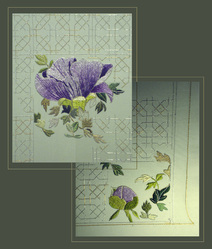For inquiries contact:brushandthreadarts@gmail.com
Sujata's exclusive Nihon Shishu works
Please click on thumbnails below to enlarge.
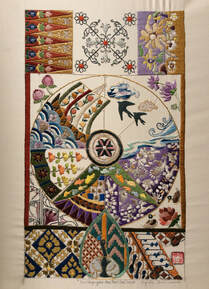
Les Voyages Des Textiles
38.5 cm * 23.2 cm
© 2020 Sujata Srinivasan
Time taken to Embroider
Approx. 700 (wo)man hours
Number of colours/ shades
90 colors / shades , additionally, Silver & Gold metallic threads
Concept & Design, Research, Embroidery by Sujata Srinivasan
Research, Digital artwork design and execution by Chitra Shriram
A Homage to the original 'influencers' - the Artisans, the Monks, the Merchants - agents of cross-cultural fertilization in the textiles of South Asia!
In this piece, I have used the techniques and materials of the classical Japanese art and craft of silk and metal embroidery called Nihon Shishu. This art form with its marvellous palette of 400 silk threads, has a great affinity to painting. It emphasizes delicacy and refinement and traditionally its imagery is largely derived from nature. It is one of the most challenging embroidery techniques in the world – to give just one example, every one of the silk threads used here have been hand-twisted by me.
I owe it to the exacting discipline of Nihon Shishu to have even attempted Les Voyages. However, in concept, imagery and certain aspects of design aesthetics, I have departed from the traditional motifs, seasonal references and typical 'look' of this embroidery style in this work.
Les Voyages Des Textiles is a journey through the kaleidoscope of my own personal experiences and admiration for the rich fabric traditions of my country, India, and those of our South-east Asian neighbours. From the 17th to the 19th centuries in particular, Indian textile crafts and colours exerted a tremendous influence through export, even as far as the Far East and in the west, as far as Europe.
Motifs in Les Voyages Des Textiles refer to: the Indian Patola (double Ikat with its origins in Gujarat); the ‘temple’ motif in Indian saris which has extended to Indonesian garments; Ajrakh (hand block printing) and Kalamkari (hand painting on cotton), at one time widely exported to S-East Asia, Japan and Europe; Indian Bandhni (tie and dye); Thai and Indonesian textile patterns and crafts including Batik resist dyeing; the Indian sari with double and contrasting borders and using Zari (gold thread); the gorgeous Ghara embroidered sari exemplifying cross-cultural fusion at its best- with Chinese/Persian motifs, originally embroidered in China to be worn by Parsi women in India
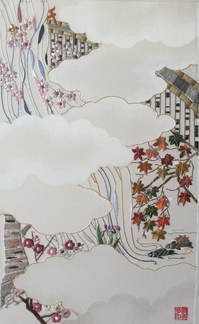
Four Seasons
38.0 cm * 24.0 cm
© 2017 Sujata Srinivasan
Billowing white clouds traversing the sky, both concealing and revealing!
This delicate, silk kimono fabric, with its woven pattern of clouds seemed to set the stage for the unfolding drama of the 4 seasons which I had so enjoyed in Japan! I used the cloud motif to link as well as separate the representative motifs of each season - the cherry blossoms of spring, the water and irises of summer, the maple leaves of autumn, and the plum blossoms of winter.
No one who has partaken of this abundance of nature can remain unmoved by its all-pervading spirit. Hence, the bridge spanning all the seasons leads to the orange 'torii' or gateway of a Shinto shrine where the essence and energy of all the natural world is worshipped.
38.0 cm * 24.0 cm
© 2017 Sujata Srinivasan
Billowing white clouds traversing the sky, both concealing and revealing!
This delicate, silk kimono fabric, with its woven pattern of clouds seemed to set the stage for the unfolding drama of the 4 seasons which I had so enjoyed in Japan! I used the cloud motif to link as well as separate the representative motifs of each season - the cherry blossoms of spring, the water and irises of summer, the maple leaves of autumn, and the plum blossoms of winter.
No one who has partaken of this abundance of nature can remain unmoved by its all-pervading spirit. Hence, the bridge spanning all the seasons leads to the orange 'torii' or gateway of a Shinto shrine where the essence and energy of all the natural world is worshipped.
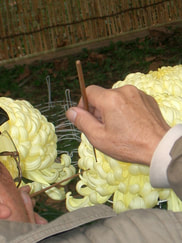 Garden Specialist,
Hibiya Park, Tokyo
Garden Specialist,
Hibiya Park, Tokyo
Till I came upon this scene of a garden specialist teasing out the curls of their petals, I did not know that chrysanthemums were groomed like the rest of us, to look their best at the annual Chrysanthemum Festival!! I thought they just grew that way!! Looking all spiffy and chic!
My imagination ran with this and soon ‘Ms. Chrysanthemum and Kanzashi (traditional Japanese hair ornaments)' was flying in the air!
Kanzashi, which is one of my favourite ornamental Japanese crafts, is used here as a symbolic element in this saga of Ms.Chrysanthemum getting ready to hit the town! The silk fabric which I picked up at a flea market was just what I was looking for, to weave seamlessly between the petals and hold them together.
My imagination ran with this and soon ‘Ms. Chrysanthemum and Kanzashi (traditional Japanese hair ornaments)' was flying in the air!
Kanzashi, which is one of my favourite ornamental Japanese crafts, is used here as a symbolic element in this saga of Ms.Chrysanthemum getting ready to hit the town! The silk fabric which I picked up at a flea market was just what I was looking for, to weave seamlessly between the petals and hold them together.
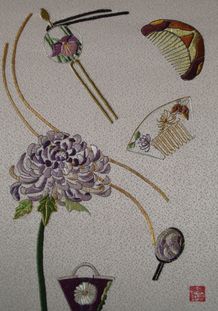
Ms. Chrysanthemum & Kanzashi
34.7cm * 24.1 cm
© 2016 Sujata Srinivasan
The saga of Ms. Chrysanthemum
getting ready to hit the town!
(See Above)
Ms. Chrysanthemum & Kanzashi
34.7cm * 24.1 cm
© 2016 Sujata Srinivasan
The saga of Ms. Chrysanthemum
getting ready to hit the town!
(See Above)
|
A Child's Book of Dreams
21cm * 18 cm © 2010 Sujata Srinivasan The inspiration for this was the morning glories that undulated with such purple abandon where I lived and calla lilies that contrasted with an erect grace reminiscent of champagne glasses. Once i had chosen the silk fabric for the piece,there was no doubt that this was a book cover for a child’s dreams! |

